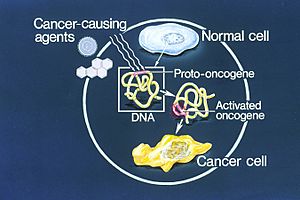Oncogene facts for kids
An oncogene is a special kind of gene that can make a cell grow out of control. When a cell grows too much and doesn't stop, it can lead to cancer. So, you can think of oncogenes as genes that cause cells to divide without limits.
In cancer cells, oncogenes are often changed or "mutated." This means their instructions are wrong. Sometimes, they are also "expressed" at very high levels. This means the cell makes too much of the protein that the oncogene tells it to make.
Normally, cells have a plan to die when they are old or damaged. This is called apoptosis. But activated oncogenes can stop these cells from dying. Instead, they keep growing and multiplying. Often, oncogenes need other things to happen to cause cancer. This could be other mutations in different genes. It could also be things from the environment, like a virus infection. Since the 1970s, scientists have found many oncogenes in human cancers. Many medicines used to treat cancer work by targeting the proteins made by these oncogenes.
In 1976, two scientists, J. Michael Bishop and Harold Varmus, made an important discovery. They worked at the University of California, San Francisco. They showed that oncogenes are actually "activated" versions of normal genes. These normal genes are called proto-oncogenes. Proto-oncogenes are found in many living things, including humans. For their amazing discovery, Bishop and Varmus won the Nobel Prize in Physiology or Medicine in 1989.
Contents
How Scientists Understood Oncogenes Better
The work done by Bishop and Varmus helped correct an old misunderstanding. The Nobel Prize explanation mentioned this:
"The word 'oncogene' was first used in the mid-1960s. It described special parts of the genetic material found in certain viruses. People thought that these viral genes could turn a normal cell into a cancer cell. The popular idea at the time was that all cancers started this way. They thought viruses passed oncogenes from cell to cell. But this idea was later proven to be wrong."
Actually, scientists found that viruses can copy their RNA into DNA. This process is called reverse transcription. This viral DNA, including the oncogenes, then became part of the cell's own DNA. Later, scientists found that similar "oncogene-like" material was in many animals. It was even in simple organisms with just a few cells. They also learned that these genes had a fixed place in a species' chromosomes. When these genes were part of the cell's own DNA, they were often broken into pieces. This showed that oncogenes weren't just from viruses. They were normal parts of a cell's genetic code that could go wrong.
Proto-oncogenes: The Normal Version
A proto-oncogene is a normal gene that helps a cell work properly. It can become an oncogene if it gets a mutation or if it's used too much. When a proto-oncogene turns into an oncogene, the protein it makes is called an oncoprotein.
Proto-oncogenes make proteins that help control how cells grow. They also help cells become specialized for different jobs. These genes are often involved in sending signals inside the cell. They help carry out messages that tell cells to grow and divide. When a proto-oncogene is "activated," it changes. Then, it becomes an oncogene, which can cause tumors.
Examples of Oncogenes
One example is the MYC gene. This gene is linked to a type of cancer called Burkitt's Lymphoma. This cancer starts when a part of a chromosome moves to the wrong place. This movement is called a chromosomal translocation. It puts a special "enhancer" sequence too close to the MYC gene. The MYC gene makes proteins called transcription factors. These factors help turn other genes on or off. When the enhancer is in the wrong spot, the cell makes many more of these transcription factors than it should.
Another example is the Bcr-Abl gene. This gene is found on something called the 'Philadelphia Chromosome'. This is a piece of genetic material seen in a type of blood cancer called Chronic Myelogenous Leukemia. It happens when pieces from chromosomes 9 and 22 swap places. The Bcr-Abl gene makes a protein called a receptor tyrosine kinase. This protein is always active, which causes cells to grow and divide without stopping.
See also
 In Spanish: Oncogén para niños
In Spanish: Oncogén para niños


